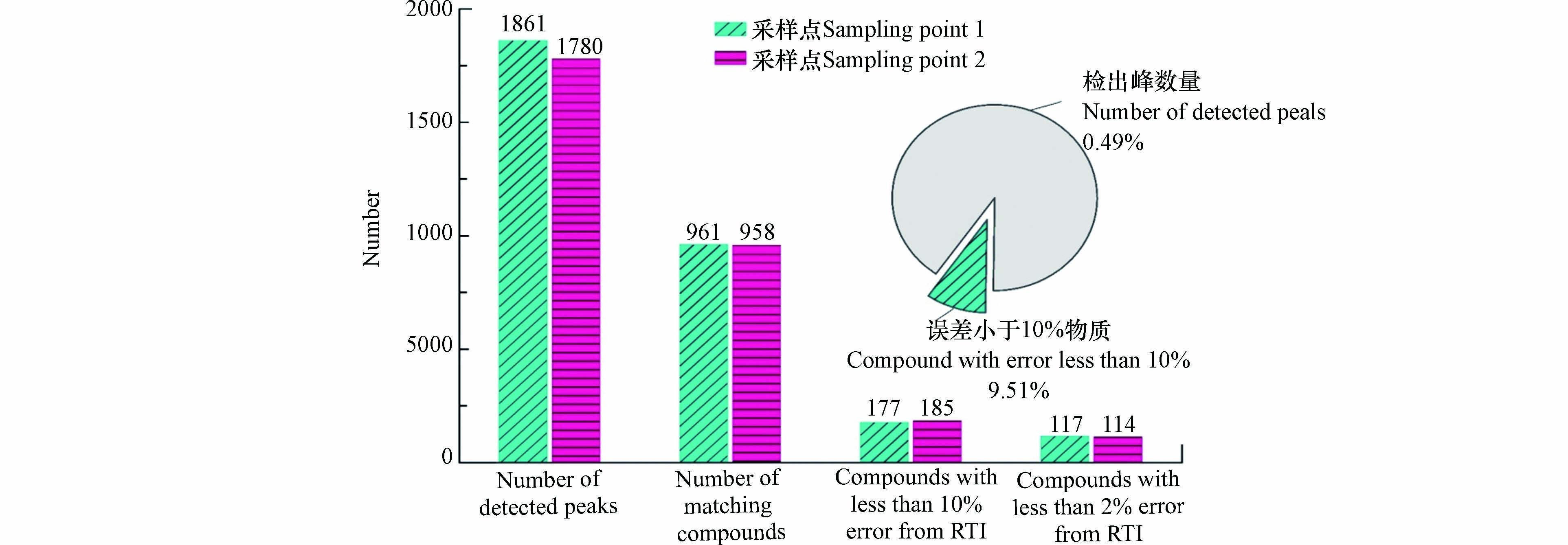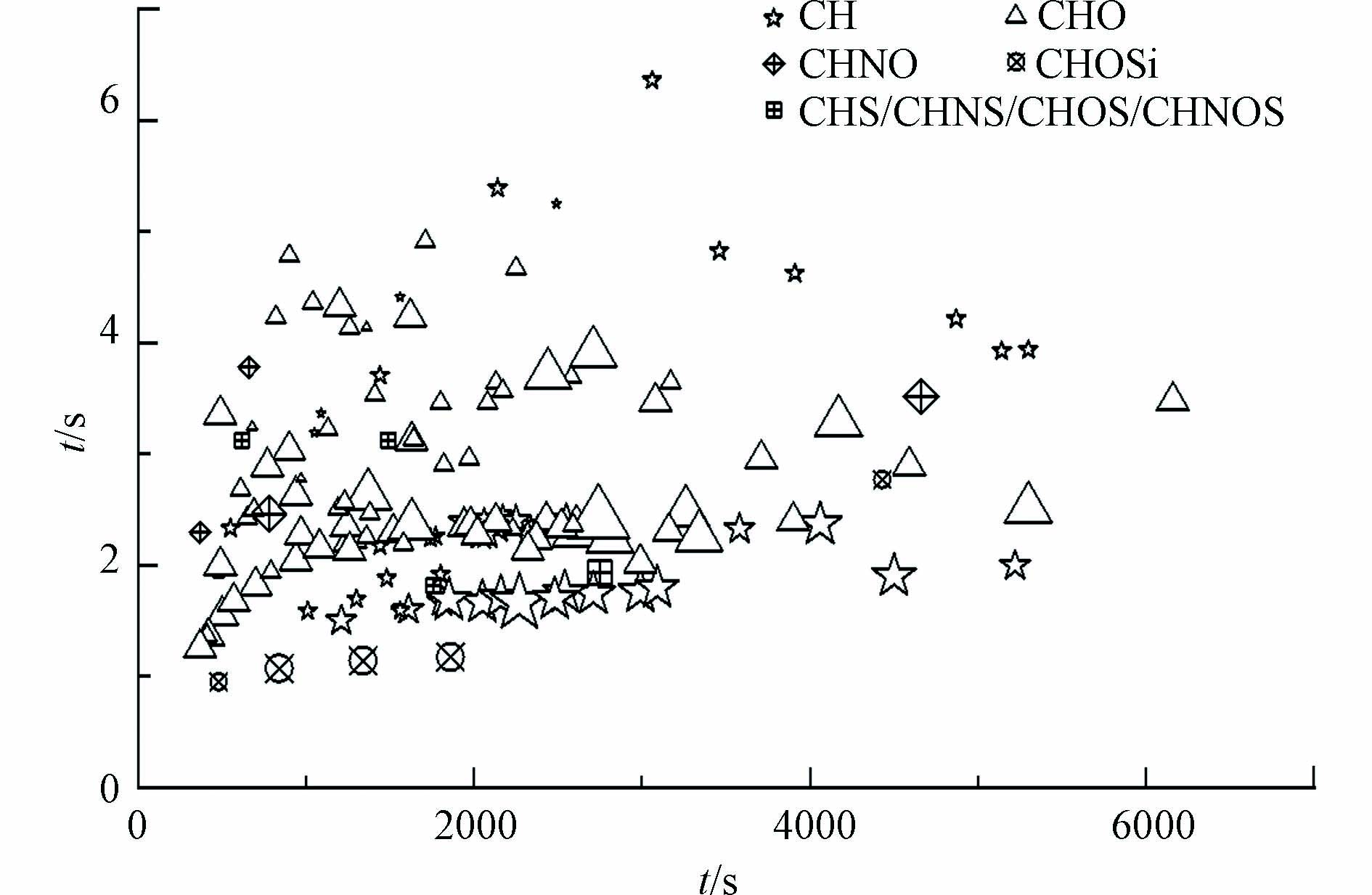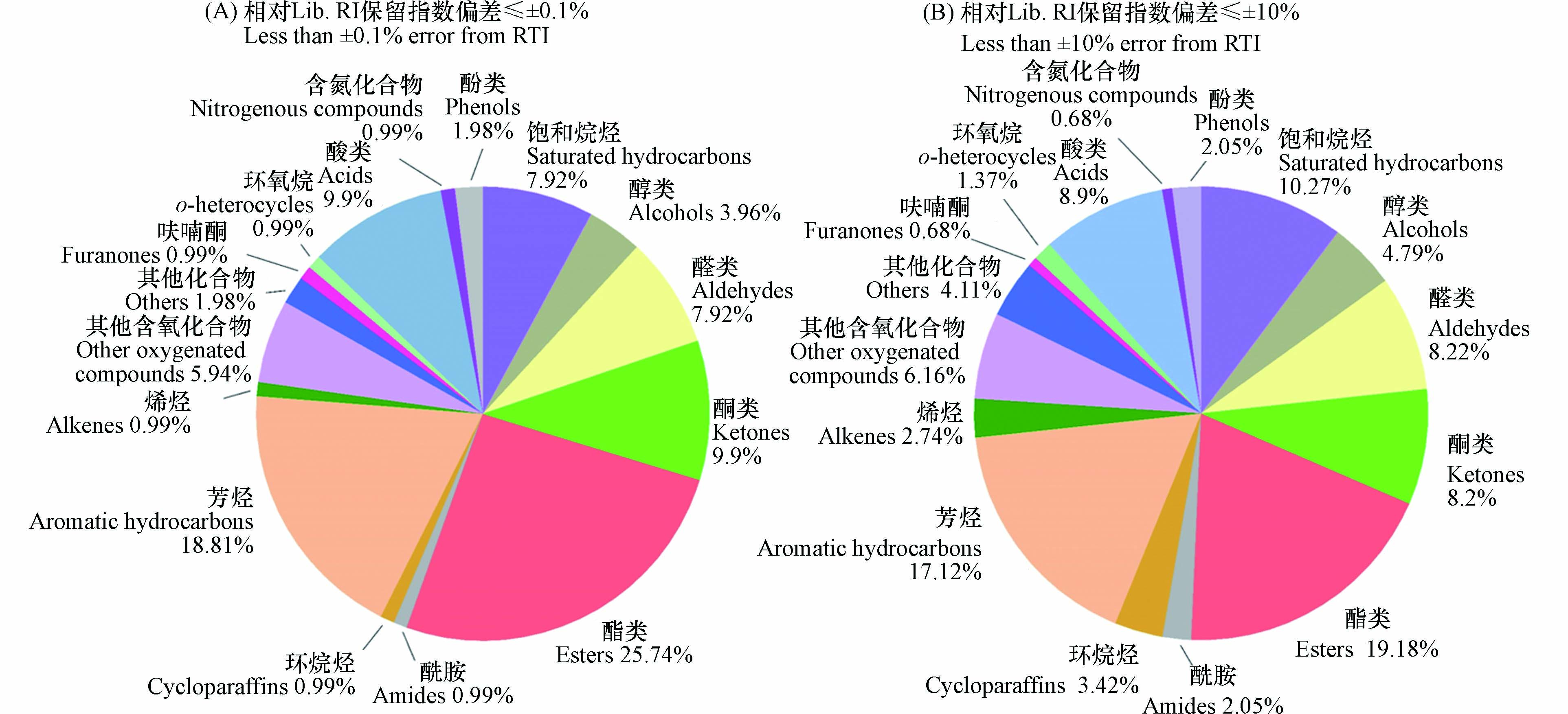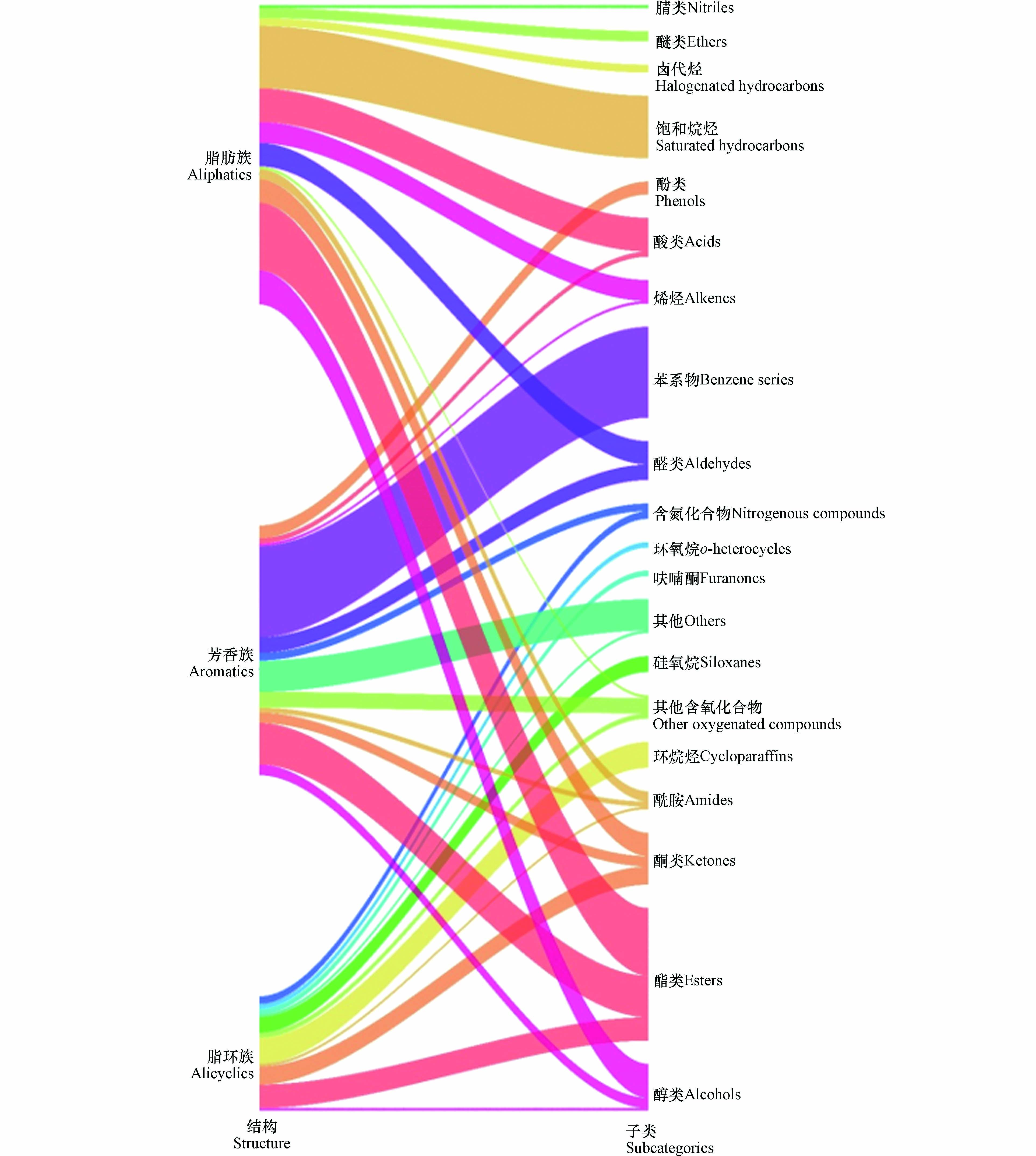-
由于近年来我国经济的快速发展与工业化的逐步加速,水体的化学污染日益严重,并影响到了水源地饮用水的安全[1-4]. 水源地中检出的各类有机微污染物浓度较低,并且环境体系基质较为复杂。在使用传统的一维气相色谱质谱联用技术(GC-MS)对这类复杂样品进行分析时,通常不能将混合物充分分离,造成组分共洗脱、峰容量不足的现象,且无法达到较低的检测限,为有机物的鉴定带来困难[5].
全二维气相色谱是通过调制器将两根相互独立,极性不同,分离机理不同的色谱柱串联起来,从而提供物质的正交分离,使峰容量极大提高[6-9]. 同时,由于调制器的聚焦作用,使得全二维气相色谱与一维气相色谱相比检测灵敏度得到提高[10-14]. 目前全二维气相色谱飞行时间质谱联用技术(GC×GC-TOFMS)对水环境中的污染物分析已有大量应用,但较多是对某种或某一类目标有机物的靶向分析研究. 何晓蕾等 [15]通过使用全二维气相色谱-飞行时间质谱测定了焦化废水中16种多环芳烃(PAHs)的含量,并通过仪器数据处理软件建立了该类废水中整体有机物的组成比对方法. 张红庆等 [16]建立了地下水中低环多环芳烃及其衍生物的GC×GC-TOFMS检测方法,用于河北地区6个地下水样品中低环多环芳烃的检测,其中4个样品有检出. Matamoros等[17]通过使用GC×GC-TOFMS同时对河流中包括农药、多环芳烃(PAHs)、药物和个人护理品(PPCPs)在内的97种痕量有机污染物进行检测,检测限(LODs)为0.5—100 ng·L−1. Teehan等[18]使用GC×GC-TOFMS对幼年小嘴鲈鱼体内有机污染物进行靶向与非靶向分析研究,对包括多氯联苯、多溴二苯醚、有机氯农药、药物与个人护理品在内的127种已知污染物进行定量分析,并通过非靶向分析发现与健康鲈鱼相比,患病鲈鱼体内中酯类、酮类、含氮化合物含量增加. 对于目标有机物的靶向分析只能对已知污染物进行定性定量研究,但在复杂的环境样本中还存在大量的未知污染物,当今随着对新兴污染物的识别分析、生态与环境风险评估等领域研究的逐步重视,对于大量未知化合物具有较好分离效果,同时具备较低检出限、较高分辨率的非靶向高通量筛查技术也逐步为研究人员所需要,GC×GC-TOFMS是同时具备以上优点的检测方法.
本文通过使用GC×GC-TOFMS对我国东南地区某水库水源地进行有机污染物非靶向筛查,通过RTI指数的筛查提升识别结果的准确性. 之后对检出丰度较高的污染物种类与特征进行了定性分析,以期为我国水源地中未知污染物的识别提供参考.
-
Pegasus GC-HRT 4D+全二维气相色谱-飞行时间质谱(GC×GC-TOFMS),美国Leco公司;色谱柱1为非极性色谱柱Rtx-5MS(30 m×0.25 mm×0.25 μm,美国Restek公司),色谱柱2为中等极性色谱柱Rxi-17SilMS(2.0 m×0.25 mm×0.25 μm,美国Restek公司);Milli-Q超纯水系统(美国Restek公司);0.45 μm玻璃纤维滤膜(美国Millipore公司);正己烷(色谱纯,美国Fisher Scientific公司);无水乙醇、无水硫酸钠(分析纯,北京化学试剂厂).
-
将水样过孔径0.45 μm玻璃纤维滤膜,量取500 mL滤液于1 L分液漏斗中,加入20 mL正己烷萃取溶剂进行液液萃取,于振荡器上恒温(25 ℃)振荡15 min,加入少许无水乙醇破乳,静置10 min使水相与有机相分层,之后将有机相转移至平底烧瓶中,加入适量无水硫酸钠除水,旋转蒸发浓缩至约3 mL后转移至KD浓缩瓶,在氮吹仪上通过缓和氮气进行氮吹,定容至0.1 mL后使用聚四氟乙烯膜封口,待GC×GC-TOFMS分析.
-
进样口温度280 ℃;进样方式:不分流进样;进样量1 μL;载气:氦气(纯度≥99.999 %);流速1 mL·min−1;柱温程序:初始温度60 ℃,保持3 min;以3 ℃· min−1升至300 ℃;调制周期5 s.
-
离子化方式:电子轰击电离EI,电离电压:70 eV;离子源温度:240 ℃;扫描方式:m/z 40—500全扫描;采集谱图速率:100张·s−1. 使用ChromaTOF软件对谱图进行分析,结果与NIST17标准谱库进行匹配比对. 对空白样品进行分析,并从实际样品中扣除其信号,在此之后计算信噪比大于10,且与NIST谱库匹配度大于650的化合物峰面积.
-
通过使用ChromaTOF软件对数据进行处理,包括质量校准、选峰与保留指数计算. 在所指定的相对分子质量范围内进行全扫,将所得到的质谱图与NIST谱库进行比对筛选,所得到的结果包含多个可能的化合物,选取匹配度最高的化合物,记录其名称、CAS编号、相对分子质量、一维与二维气相色谱保留时间、峰面积等信息进行进一步判定与分析. 将所得到结果中化合物的保留时间指数(RTI)与保留时间指数库文献值进行对比,分别筛选出相对于谱库保留时间指数偏差在± 1%、± 2%与± 10%以内的化合物进行分析.
-
本研究在水库中设置了5个采样点,分别对每个采样点数据进行处理,筛选出相对于谱库保留时间指数偏差在± 2%与± 10%以内的化合物进行分析. 选取其中的2个点位,如图1所示,经过谱图分析的数据在每个数据点中会得到高于1000个检出峰,在与标准谱库进行匹配筛选之后,匹配物质数量占检出峰数量的一半左右,再对其进行筛选,在考虑同分异构体的基础上分别得到相对于谱库RTI偏差在± 10%以内的物质177种和185种,偏差在± 2%以内的物质117种和114种. 相对于谱库RTI偏差在± 10%以内的物质匹配结果相对准确,选取此区间的物质进行下一步研究. 可以看到,检出峰数量、匹配物质数量与最终的准确结果存在较大的误差,如不进行匹配筛选,会严重影响最终结果的准确性.
选取采样点位中的一个样本,列出此点位相对于谱库RTI偏差在± 2%之内的化合物中峰面积最高的10种物质,如表1所示;列出此点位相对于谱库RTI偏差在± 2% — ± 10%之间的化合物中峰面积最高的10种物质,如表2所示. 从表1与表2中可以看出,误差在± 2%范围内的化合物峰面积相比于± 2% — ± 10%的化合物较高. 保留时间指数误差在± 2%之内时由于其误差很小,因此将其完全定性为所预测的化合物,而误差在± 2% — ± 10%之间时由于其误差偏大,只能将其确定为疑似化合物.
-
由仪器所测定的化合物按元素组成分为以下几类:CH、CHO、CHNO、CHOSi,CHS、CHNS、CHOS、CHNOS. 对相对于谱库RTI偏差≤10%的化合物进行分析,如表3所示,在各采样点中CH与CHO类化合物占全部化合物的绝大多数. 元素组成为CH的化合物峰面积占比与数量占比分别为32.65% — 63.04%和27.05%—37.50%,其中包括饱和烷烃,环烷烃,单环芳烃,多环芳烃与烯烃. 元素组成为CHO的化合物峰面积占比与数量占比分别为34.64%—61.80%和51.56%—61.48%,其中包括醇类,醛类,酸类,酮类,酯类,呋喃酮,环氧烷与酚类物质. 元素组成为CHNO的化合物峰面积占比与数量占比分别为0.50%—2.01%和2.74%—7.24%,其中包括酰胺,酮类与酯类. 元素组成为CHOSi的化合物峰面积占比与数量占比分别为0.73%—3.33%和3.42%—4.69%,其全部为硅氧烷类物质. 元素组成为CHS/CHNS/CHOS/CHNOS的化合物峰面积占比与数量占比分别为0.13%—0.78%和0.66%—2.74%,其中包括噻唑,噻吩类物质.
各元素组成物质的全二维气相色谱保留时间分布见图2,通过符号表示物质的元素组成,符号大小正比于此物质的峰面积.. 由图2可以看出,大部分物质组成为CH与CHO,峰面积较高的物质包括植烷(保留时间:2270 s、1.66 s)、2,2,4-三甲基-1,3-戊二醇二异丁酸酯(保留时间:1630 s、2.355 s)、棕榈酸(保留时间:2740 s、2.405 s)等物质.
-
根据质谱与全二维气相色谱保留性质,可确定饱和烷烃、烯烃、醇、醚、单环芳烃与多环芳烃类物质的全二维保留时间. 图3选取了采样点中的1个样本,图中红色范围内主要为饱和烷烃、烯烃、醇、醚类物质,黄色区域为单环芳烃,绿色区域为多环芳烃. 从图3可以明显看出,水体中饱和烷烃、烯烃、醇、醚类物质与单环芳烃、多环芳烃相比含量较大.
Mohler等[19]使用全二维气相色谱-飞行时间质谱(GC×GC-TOFMS)对燃料释放点附近地下水中的石油代谢物进行非靶向分析,通过该方法鉴定出了760多种极性化合物. 卢昕妍等[20]通过使用超高效液相色谱-飞行时间质谱(UPLC-TOFMS)对太湖西岸地表水体中潜在极性有机污染物进行非靶向筛查,共检测出包括农药、药物、个人护理品、添加剂、有机合成中间体、动植物代谢物或天然物质在内的162种有机物. 周秀花[21]使用GC×GC-TOFMS对官厅水库及其上游的永定河流域表层水体中有机物进行高通量非靶向定性筛查,官厅水库平均检出有机物708种,主要包括烷烃类、酯类、酮类、醇类、农药类、胺类、多环芳烃类物质. 本研究从所检测的5个采样点中分别鉴定出64—187种有机物,根据碳骨架将其分为三类:脂肪族、脂环族与芳香族化合物,再细分为20个子类:腈类、醚类、卤代烃、饱和烷烃、酚类、酸类、烯烃、苯系物、醛类、含氮化合物、环氧烷、呋喃酮、硅氧烷、其他含氧化合物、环烷烃、酰胺、酮类、酯类、醇类、其他.
选取其中一个采样点数据对相对于谱库不同保留时间指数偏差范围内的物质种类进行对比,如图4所示,相对于谱库RTI偏差在± 1%和± 10%范围内数据中的整体物质类别变化不大,仅酯类、饱和烷烃、环烷烃等少数几类物质在相对谱库RTI偏差不同时检出概率有一定区别,从中可以看出,检出物质的种类不会随相对谱库RTI偏差的不同而产生较大影响.
对相对于谱库保留时间指数偏差≤10%的化合物进行分析,图5展示了所检出全部化合物的详细分类,不同颜色代表不同子类,面积大小表示检出化合物的种类数量. 所有样品中脂肪族化合物的种类最多,共检测出115种. 脂肪族化合物检出较多的子类包括酯类(各样品分别含有9—20种)、饱和烷烃(13—17种)、酸类(6—13种)、醛类(3—9种)、醇类(2—7种). 芳香族化合物共检测出96种,检出较多的子类包括苯系物(9—19种)、酯类(7—12种)、其他含氧化合物(0—6种)、醛类(0—5种). 脂环族化合物的种类最少,共检测出44种,其中检出较多的子类包括酮类(1—6种)、酯类(1—6种)、硅氧烷(3—5种)、环烷烃(0—5种). 李昆等[22]利用全二维气相色谱飞行时间质谱联用的方法对潘家口水库水体有机物进行高通量筛查,2017年水体中共筛查出288种有机物,包括烷烃类(28%)、烯烃类(15%)、有机酸类(13%)、酯类(11%)、醛类(9%)等,2018年经过水库网箱清理之后共筛查出66种有机物,本文所研究的水库水体与文献中有机物整体水平相类似.
在本研究的5个采样点中分别检出3—5种硅氧烷类物质,目前有关硅氧烷类物质在水源地水体中检出的报道较少,本研究水体中硅氧烷的检出可能与当地电子废弃物回收行业较为发达有关[23]. 各采样点位所检出的硅氧烷类物质全部为环形甲基硅氧烷,此类物质广泛用于合成有机硅生产品,与线形甲基硅氧烷相比,环形甲基硅氧烷挥发性较强,容易从污染源区域挥发进入大气,进而远距离迁移进入到水体当中,线形甲基硅氧烷在本研究中未有检出可能与此相关[24]. 在本研究各采样点中均检出了十甲基环五硅氧烷(D5)与十二甲基环六硅氧烷(D6),这两种物质由于其具有的持久性、毒性与潜在的生物累积性而被提议列入至斯德哥尔摩持久性有机污染物(persistent organic pollutants, POPs)公约审议清单之中[25].
-
本研究通过使用全二维气相色谱-飞行时间质谱联用技术对水库水体中的有机微污染物进行了非靶向定性筛查,通过使用谱库匹配、筛选与谱库保留时间指数偏差在± 10%,± 2%以内化合物的方法极大提高了未知污染物筛查的准确性. 所检出化合物绝大部分的元素组成为CH和CHO. 检出物质的种类不会随相对谱库保留时间指数偏差的不同而产生较大影响. 所检出各种类物质中约一半为脂肪族结构物质,全部化合物中检出物质种类最多的子类为酯类. 本文通过开发一种新的非靶向筛查方法探究了我国东南部地区一水源地水体的整体有机物构成,为今后水质评价、生态风险评估等工作的开展提供了有力的方法保障.
全二维气相色谱-飞行时间质谱(GC×GC-TOFMS)非靶向筛查水源地中微量有机污染物
Non-targeted screening of trace organic pollutants in source water by GC×GC-TOFMS
-
摘要: 全二维气相色谱-飞行时间质谱联用技术(GC×GC-TOFMS)由于其检测限低、分离效果好等优势已广泛应用于环境领域研究中. 通过使用此技术对我国东南地区水库中有机微污染物进行非靶向定性筛查,在2个水体样本中分别检测出1780、1861个质谱峰,通过谱库匹配,分别匹配到958、961个化合物,其中与谱库保留时间指数偏差在±10%以内的物质185、177种,±2%以内的物质114、117种,通过对保留时间指数进行控制,提升了非靶向识别的准确性. 全部5个采样点中保留指数偏差在±10%以内共识别出255种有机物,包括脂肪族化合物115种、芳香族化合物96种、脂环族化合物44种;元素组成为CH和CHO的化合物占比83.33%—89.73%,占检出物质的绝大多数. 全二维气相色谱-飞行时间质谱技术能够准确地定性筛查出环境水体中大量未知有机微污染物,为识别水质特征提供重要依据.
-
关键词:
- 全二维气相色谱-飞行时间质谱 /
- 有机组分 /
- 非靶向分析 /
- 水源
Abstract: Comprehensive two-dimensional gas chromatography coupled to time-of-flight mass spectrometry (GC×GC-TOFMS) has been widely used in environmental research due to its advantages of low detection limit and good separation effect. By using this technique, non-targeted qualitative screening of trace organic pollutants in reservoir water in Southeast China were conducted in this study and 1780, 1861 peaks were detected in 2 water samples. 958, 961 substance results were matched through mass spectral library matching, among which 185, 177 substances deviated from the mass spectral library retention index within ± 10%, and 114, 117 within ± 2%. By controlling the retention time index, the accuracy of non-targeted recognition is improved. 255 organic compounds, including 115 aliphatic compounds, 96 aromatic compounds and 44 alicyclic compounds, were identified with the retention index deviation within ±10% at all 5 sampling sites. Compounds composed of CH and CHO accounted for 83.33%—89.73%, accounting for the majority of detected substances. Comprehensive two-dimensional gas chromatography coupled to time-of-flight mass spectrometry can accurately and qualitatively screen a large number of unknown organic micropollutants in environmental water, providing an important basis for identifying water quality characteristics.-
Key words:
- GC×GC-TOFMS /
- organic component /
- non-targeted analysis /
- water source.
-

-
表 1 峰面积最高10种化合物的保留时间、保留时间指数与峰面积(± 2%)
Table 1. Retention time, retention time index and peak area of the 10 compounds with the highest peak area (± 2%)
化合物
CompoundCAS号
CAS No.保留时间/s
Retention time保留时间指数
Retention time index峰面积
Peak area一维
1D二维
2D计算值
Value of calculation谱库
Value of references误差
Error棕榈酸 57-10-3 2740 2.405 1971.4 1968 0.0017 127084825 植烷 638-36-8 2270 1.66 1810 1792 0.0100 119510764 2,2,4-三甲基-1,3-戊二醇二异丁酸酯 6846-50-0 1630 2.355 1600 1588 0.0075 87311395 正二十七烷 593-49-7 4500 1.901 2700 2700 0 84183675 正十九烷 629-92-5 2540 1.75 1900 1900 0 68729599 邻苯二甲酸二(2-乙基己基)酯 117-81-7 4170 3.29 2546 2529 0.0065 65372134 邻苯二甲酸二异丁酯 84-69-5 2440 3.71 1867 1870 -0.0017 53808241 邻苯二甲酸二丁酯 84-74-2 2710 3.91 1961 1965 -0.0021 51905211 3-甲基十七烷 6418-44-6 2160 1.705 1773.3 1770 0.0018 46760307 2-甲基十九烷 1560-86-7 2710 1.74 1960.7 1963 -0.0011 45302799 表 2 峰面积最高10种化合物的保留时间、保留时间指数与峰面积(± 2%—± 10%)
Table 2. Retention time, retention time index and peak area of the 10 compounds with the highest peak area (± 2%—± 10%)
化合物
CompoundCAS号
CAS No.保留时间/s
Retention time保留时间指数
Retention time index峰面积
Peak area一维
1D二维
2D计算值
Value of calculation谱库值
Value of references误差
Error二十六碳-1-烯 18835-33-1 4060 2.365 2495.7 2593 −0.0375 46696625 正十八烷 593-45-3 2480 1.695 1880 1800 0.0444 42040238 2-甲基十八烷 1560-88-9 2050 1.665 1736.7 1863 −0.0677 16029795 芥酸酰胺 112-84-5 4660 3.515 2776 2625 0.0576 8713692 1-二十二烯 1599-67-3 3580 2.325 2292 2193 0.0451 7617602 27-甲基二十八烷 1560-98-1 5220 1.995 3063.2 2859 0.0714 5526594 十九烷醇 1454-84-8 2990 2.018 2063 2176 −0.0519 4946841 十一醇 112-42-5 1260 2.13 1476.7 1371 0.0771 4553385 二十烷醛 2400-66-0 3900 2.395 2426.1 2224 0.0909 4085180 正十七烷 629-78-7 1610 1.6 1593.3 1700 −0.0628 3560206 表 3 各元素组成峰面积占比与数量占比
Table 3. Proportion of peak area and quantity of each element composition
元素组成
Element composition峰面积占比
Proportion of total peak area数量占比
Proportion of quantityCH 32.65%—63.04% 27.05%—37.50% CHO 34.64%—61.80% 51.56%—61.48% CHNO 0.50%—2.01% 2.74%—7.24% CHOSi 0.73%—3.33% 3.42%—4.69% CHS/CHNS/CHOS/CHNOS 0.13%—0.78% 0.66%—2.74% -
[1] LI X F, MITCH W A. Drinking water disinfection byproducts (DBPs) and human health effects: Multidisciplinary challenges and opportunities [J]. Environmental Science & Technology, 2018, 52(4): 1681-1689. [2] BLUM K M, ANDERSSON P L, AHRENS L, et al. Persistence, mobility and bioavailability of emerging organic contaminants discharged from sewage treatment plants [J]. Science of the Total Environment, 2018, 612: 1532-1542. doi: 10.1016/j.scitotenv.2017.09.006 [3] 邵珠涛. 水环境污染现状及其治理对策 [J]. 中国资源综合利用, 2017, 35(4): 14-15,18. doi: 10.3969/j.issn.1008-9500.2017.04.011 SHAO Z T. Current situation and countermeasures of water environment pollution [J]. China Resources Comprehensive Utilization, 2017, 35(4): 14-15,18(in Chinese). doi: 10.3969/j.issn.1008-9500.2017.04.011
[4] 吴晓红. 我国水污染现状及治理措施 [J]. 环境与发展, 2017, 29(3): 80-81. doi: 10.16647/j.cnki.cn15-1369/X.2017.03.038 WU X H. Present situation of water pollution in China and its control measures [J]. Environment and Development, 2017, 29(3): 80-81(in Chinese). doi: 10.16647/j.cnki.cn15-1369/X.2017.03.038
[5] MONDELLO L, TRANCHIDA P Q, DUGO P, et al. Comprehensive two-dimensional gas chromatography-mass spectrometry: A review [J]. Mass Spectrometry Reviews, 2008, 27(2): 101-124. doi: 10.1002/mas.20158 [6] KLEE M S, COCHRAN J, MERRICK M, et al. Evaluation of conditions of comprehensive two-dimensional gas chromatography that yield a near-theoretical maximum in peak capacity gain [J]. Journal of Chromatography A, 2015, 1383: 151-159. doi: 10.1016/j.chroma.2015.01.031 [7] ADAHCHOUR M, BEENS J, BRINKMAN U A T. Recent developments in the application of comprehensive two-dimensional gas chromatography [J]. Journal of Chromatography A, 2008, 1186(1/2): 67-108. [8] CASTILLO S, MATTILA I, MIETTINEN J, et al. Data analysis tool for comprehensive two-dimensional gas chromatography/time-of-flight mass spectrometry [J]. Analytical Chemistry, 2011, 83(8): 3058-3067. doi: 10.1021/ac103308x [9] AMARAL M S S, NOLVACHAI Y, MARRIOTT P J. Comprehensive two-dimensional gas chromatography advances in technology and applications: Biennial update [J]. Analytical Chemistry, 2020, 92(1): 85-104. doi: 10.1021/acs.analchem.9b05412 [10] 兰天宇, 杜海军. 全二维气相色谱技术在环境分析中的应用 [J]. 化工技术与开发, 2017, 46(4): 24-26. doi: 10.3969/j.issn.1671-9905.2017.04.007 LAN T Y, DU H J. Application of comprehensive two-dimensional gas chromatography in environmental analysis [J]. Technology & Development of Chemical Industry, 2017, 46(4): 24-26(in Chinese). doi: 10.3969/j.issn.1671-9905.2017.04.007
[11] 夏丹, 高丽荣, 郑明辉. 全二维气相色谱分析持久性有机污染物的应用进展 [J]. 色谱, 2017, 35(1): 91-98. doi: 10.3724/SP.J.1123.2016.08029 XIA D, GAO L R, ZHENG M H. Recent developments in comprehensive two-dimensional gas chromatography for the analysis of persistent organic pollutants [J]. Chinese Journal of Chromatography, 2017, 35(1): 91-98(in Chinese). doi: 10.3724/SP.J.1123.2016.08029
[12] TRANCHIDA P Q, PURCARO G, DUGO P, et al. Modulators for comprehensive two-dimensional gas chromatography [J]. TrAC Trends in Analytical Chemistry, 2011, 30(9): 1437-1461. doi: 10.1016/j.trac.2011.06.010 [13] MARRIOTT P J, CHIN S T, MAIKHUNTHOD B, et al. Multidimensional gas chromatography [J]. TrAC Trends in Analytical Chemistry, 2012, 34: 1-21. doi: 10.1016/j.trac.2011.10.013 [14] GRÖGER T M, KÄFER U, ZIMMERMANN R. Gas chromatography in combination with fast high-resolution time-of-flight mass spectrometry: Technical overview and perspectives for data visualization [J]. TrAC Trends in Analytical Chemistry, 2020, 122: 115677. doi: 10.1016/j.trac.2019.115677 [15] 何晓蕾, 洪涛, 张毅. 全二维气相色谱-飞行时间质谱法测定焦化废水中多环芳烃含量及此类废水中整体有机物组成的评估 [J]. 理化检验-化学分册, 2018, 54(10): 1122-1128. HE X L, HONG T, ZHANG Y. Determination of polycyclic aromatic hydrocarbons in coking wastewater by comprehensive 2-dimensional GC-TOF-MS and comment on total composition of organic components in the wastewater [J]. Physical Testing and Chemical Analysis (Part B:Chemical Analysis), 2018, 54(10): 1122-1128(in Chinese).
[16] 张红庆, 饶竹, 王晓春, 等. 全二维气相色谱-飞行时间质谱测定地下水中低环多环芳烃及其衍生物 [J]. 分析测试学报, 2017, 36(10): 1197-1202. ZHANG H Q, RAO Z, WANG X C, et al. Determination of low-ring PAHs and their derivatives in groundwater by GC × GC-TOF MS [J]. Journal of Instrumental Analysis, 2017, 36(10): 1197-1202(in Chinese).
[17] MATAMOROS V, JOVER E, BAYONA J M. Part-per-trillion determination of pharmaceuticals, pesticides, and related organic contaminants in river water by solid-phase extraction followed by comprehensive two-dimensional gas chromatography time-of-flight mass spectrometry [J]. Analytical Chemistry, 2010, 82(2): 699-706. doi: 10.1021/ac902340e [18] TEEHAN P, SCHALL M K, BLAZER V S, et al. Targeted and non-targeted analysis of young-of-year smallmouth bass using comprehensive two-dimensional gas chromatography coupled with time-of-flight mass spectrometry [J]. Science of the Total Environment, 2022, 806: 150378. doi: 10.1016/j.scitotenv.2021.150378 [19] MOHLER R E, O’REILLY K T, ZEMO D A, et al. Non-targeted analysis of petroleum metabolites in groundwater using GC × GC-TOFMS [J]. Environmental Science & Technology, 2013, 47(18): 10471-10476. [20] 卢昕妍, 王菲, 张丽敏, 等. 太湖西岸地表水中极性有机污染物非靶向筛查与生态风险评估 [J]. 环境科学, 2021, 42(11): 5284-5293. LU X Y, WANG F, ZHANG L M, et al. Nontarget screening and ecological risk assessment of polar organic pollutants in surface water on the west bank of Taihu Lake [J]. Environmental Science, 2021, 42(11): 5284-5293(in Chinese).
[21] 周秀花. 永定河流域表层水体中有机污染物筛查及潜在风险研究[D]. 武汉: 中南民族大学, 2019. ZHOU X H. Screening and risk assessment of organic pollutants in surface waters from Yongding River Basin, China[D]. Wuhan: South-central University for Nationalities, 2019(in Chinese). [知网硕士中文][知网硕士英文] [22] 李昆, 赵晓辉, 李科林, 等. 潘家口水库水体中有机物分布特征及变化趋势分析 [J]. 人民珠江, 2020, 41(8): 98-102,110. LI K, ZHAO X H, LI K L, et al. Analysis of distribution characteristics and variation trends of organic matters in Panjiakou reservoir [J]. Pearl River, 2020, 41(8): 98-102,110(in Chinese).
[23] 何旭丹, 徐琳, 张春晖, 等. 台州电子垃圾拆解地土壤中甲基硅氧烷的污染特征 [J]. 环境化学, 2016, 35(11): 2287-2294. HE X D, XU L, ZHANG C H, et al. Pollution characteristics of methyl siloxanes in soil from an electronic waste(e-waste) dismantling area in Taizhou, China [J]. Environmental Chemistry, 2016, 35(11): 2287-2294(in Chinese).
[24] 张松林, 吴丽华. 环甲基硅氧烷的环境分布、行为与效应研究进展 [J]. 生态毒理学报, 2016, 11(3): 72-85. ZHANG S L, WU L H. The research progress of environmental distribution, behavior and effects of cyclic methylsiloxanes [J]. Asian Journal of Ecotoxicology, 2016, 11(3): 72-85(in Chinese).
[25] HANSSEN L, WARNER N A, BRAATHEN T, et al. Plasma concentrations of cyclic volatile methylsiloxanes (cVMS) in pregnant and postmenopausal Norwegian women and self-reported use of personal care products (PCPs) [J]. Environment International, 2013, 51: 82-87. doi: 10.1016/j.envint.2012.10.008 -




 下载:
下载:





